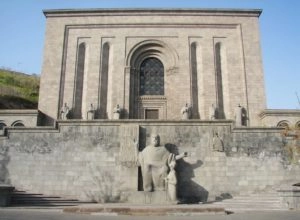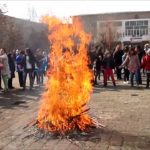National Gallery of Armenia

Founded: 1921
Theme: Art
Visitors per year: 65,000 people
Working days: Tue-Sun
Opening hours: 11:00-17:00
The National Gallery of Armenia was founded in 1921 by the decision of the Soviet Armenian Government, as the Art Department, one of the five departments of the State Museum. Martiros Sarian was appointed the Director of the museum, while Vrtanes Akhikian was named head of the Department of Arts. The State Museum was then located on Astafian (Abovyan) street, in the two-storey tufa building of boys’ gymnasium (architect V. Simonson).The museum building also housed the public library and concert hall. The building also served as a shelter for the orphans who emigrated from Western Armenia. For this reason, the museum did not hold exhibitions for the first four years after it was opened. Due to the lack of exhibitions, upon his visit to Armenia in 1924 A. Lunacharsky voiced his displeasure with the museum, comparing it with a big motley storeroom.
As evidenced by a list of invitees to the opening ceremony of the “Museum of Art” on August 14, 1921, the range of participants at this event was diverse. Among the attendees were painters, actors, musicians, officials, workers, soldiers, pupils, and students. The first visitors included famous artists Karo Halabian, Sargis Khachatrian, Taragros, Romanos Melikian and others. The opening ceremony attracted 130 people.
The first group of several dozen works was purchased by the Government for the museum in July of 1921 from the 5th exhibition of the “Union of Armenian Artists”. This exhibition was organized in the Central Club of Workers named after S. Shahumian. The works included those of famous painters Y. Tadevosian, S. Arakelian, H. Hagopian, V. Akhikian, G. Sharbabchian, the graphic artist E. Chahine, and many others.
eptember of the same year, by the decree of Moscow’s All-Russian Central Executive Committee, the former Lazarev Institute was renamed Culture House of Soviet Armenia. At this moment, its material and cultural values passed into state ownership of Armenia. This decision played a decisive role in the formation of museum’s collection, since all of the Russian and European artworks were acquired by the Armenian Museum. This emphasized the collecting practices of the museum – to accumulate works of international fine arts and decorative applied art.400 works by Armenian, Russian and European artists were certified in the “Brief list” of the Department of Fine Arts of the State Museum, published in Yerevan in 1925.Those works were exhibited in six halls. This was the first brief reference book of the museum, which in addition to other data, also included names of benefactors such as Moscow-resident, architect and engineer Hakob Ekizler (Ekizian). His donations of the works of Hovh. Aivazovsky, V. Sureniants, S. Shchedrin, I. Shishkin, V. Polenov, V. Makovsky and others are among the masterpieces of the gallery.
Generally, every museum has a unique history of its foundation. As for the State Museum, donations have played a significant role in the history of the gallery. Having a narrow escape from the Genocide, Armenian people had to leave the land of their ancestors to find shelter in the Near East, Europe and the USA. They took these countries as their second homeland, formed national communities and got engaged in the political, economic and social life of their new environment. They also got involved in cultural activity that included all the spheres of spiritual life: literature, music, and fine arts. Nevertheless, these people longed for their homeland, and remained connected with its problems and achievements. Therefore, it was quite reasonable that Armenian artists got engaged in the cultural life of reviving Armenia, especially in the foundation of the art museum.
In 1923 the People’s Commissar of Education Askanaz Mravian turned to the French-Armenian painters, asking them to help the museum to the best of their ability. His call for help received an enthusiastic response from V. Mahokian, Z. Zardarian, T. Yesayan, S. Khachatrian, R. Chichmanian and others, who by 1935 had donated a total of 40 works to the museum. Among grantor-benefactors of the first decade of the museum’s activity were painters M. Sarian, Y. Tadevosian, P. Terlemezian, V. Gayfejian, collectors V. Vahanian, D. Khan-Kelekian, V. Kananian. Donations also included the works of renowned Russian painters Al. Benois, A. Ostroumova-Lebedeva, Y. Lansere, who granted their own works to the gallery. Later on, thanks to Isaac Brodsky’s donation to the museum, the collection of Russian art was enriched with the works of world-famous 20th century artists K. Juon, B. Grigoriev, B. Anisfeld and F. Malyavin.







